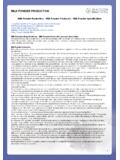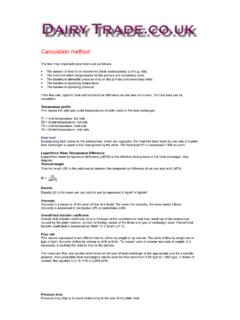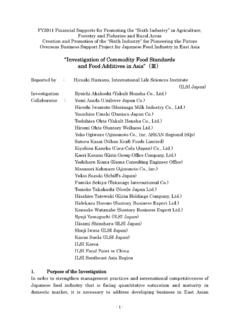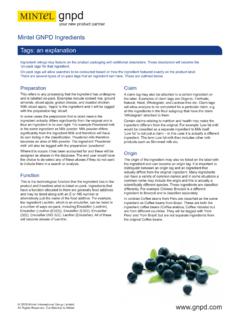Transcription of CODEX STANDARD FOR FERMENTED MILKS - …
1 CODEX STAN 243-2003 Page 1 of 5. CODEX STANDARD FOR FERMENTED MILKS . CODEX STAN 243-2003. 1. SCOPE. This STANDARD applies to FERMENTED MILKS , that is FERMENTED milk including, Heat Treated FERMENTED MILKS , Concentrated FERMENTED MILKS and composite milk products based on these products, for direct consumption or further processing in conformity with the definitions in Section 2 of this STANDARD . 2. DESCRIPTION. FERMENTED milk . FERMENTED milk is a milk product obtained by fermentation of milk , which milk may have been manufactured from products obtained from milk with or without compositional modification as limited by the provision in Section , by the action of suitable microorganisms and resulting in reduction of pH with or without coagulation (iso-electric precipitation).
2 These starter microorganisms shall be viable, active and abundant in the product to the date of minimum durability. If the product is heat-treated after fermentation the requirement for viable microorganisms does not apply. Certain FERMENTED MILKS are characterized by specific starter culture(s) used for fermentation as follows: Yoghurt: Symbiotic cultures of Streptococcus thermophilus and Lactobacillus delbrueckii subsp. bulgaricus. Alternate Culture Yoghurt: Cultures of Streptococcus thermophilus and any Lactobacillus species. Acidophilus milk : Lactobacillus acidophilus. Kefir: Starter culture prepared from kefir grains, Lactobacillus kefiri, species of the genera Leuconostoc, Lactococcus and Acetobacter growing in a strong specific relationship.
3 Kefir grains constitute both lactose fermenting yeasts (Kluyveromyces marxianus) and non-lactose-fermenting yeasts (Saccharomyces unisporus, Saccharomyces cerevisiae and Saccharomyces exiguus). Kumys: Lactobacillus delbrueckii subsp. bulgaricus and Kluyveromyces marxianus. Other microorganisms than those constituting the specific starter culture(s) specified above may be added. CONCENTRATED FERMENTED milk . Concentrated FERMENTED milk is a FERMENTED milk the protein of which has been increased prior to or after fermentation to minimum Concentrated FERMENTED MILKS includes traditional products such as Stragisto (strained yoghurt), Labneh, Ymer and Ylette. FLAVOURED FERMENTED MILKS .
4 Flavoured FERMENTED MILKS are composite milk products, as defined in Section of the CODEX General STANDARD for the Use of Dairy Terms ( CODEX STAN 206-1999) which contain a maximum of 50% (m/m). of non-dairy ingredients (such as nutritive and non nutritive sweeteners, fruits and vegetables as well as juices, purees, pulps, preparations and preserves derived therefrom, cereals, honey, chocolate, nuts, coffee, spices and other harmless natural flavouring foods) and/or flavours. The non-dairy ingredients can be mixed in prior to/or after fermentation. 3. ESSENTIAL COMPOSITION AND QUALITY FACTORS. RAW MATERIALS. milk and/or products obtained from milk . Potable water for the use in reconstitution or recombination.
5 CODEX STAN 243-2003 Page 2 of 5. PERMITTED INGREDIENTS. Starter cultures of harmless microorganisms including those specified in Section 2;. Sodium chloride; and Non-dairy ingredients as listed in Section (Flavoured FERMENTED MILKS ). Gelatine and starch in: - FERMENTED MILKS heat-treated after fermentation;. - flavoured FERMENTED milk ; and - plain FERMENTED MILKS if permitted by national legislation in the country of sale to the final consumer;. provided they are added only in amounts functionally necessary as governed by Good Manufacturing Practice, taking into account any use of the stabilizers/thickeners listed in section 4. These substances may be added either before or after adding the non-dairy ingredients.
6 COMPOSITION. FERMENTED Yoghurt, Alternate Kefir Kumys milk Culture Yoghurt and Acidophilus milk milk proteina (% m/m) min. min. min. milk fat (% m/m) less than 10% less than 15% less than 10% less than 10%. Titrable acidity, expressed as % min. min. min. min. lactic acid (% m/m). Ethanol (% ) min. Sum of microorganisms min. 107 min. 107 min. 107 min. 107. constituting the starter culture defined in section (cfu/g, in total). Labelled microorganismsb (cfu/g, min. 106 min. 106. total). Yeasts (cfu/g) min. 104 min. 104. a ) Protein content is multiplied by the total Kjeldahl nitrogen determined. b ) Applies where a content claim is made in the labelling that refers to the presence of a specific microorganism (other than those specified in section for the product concerned) that has been added as a supplement to the specific starter culture.
7 In Flavoured FERMENTED MILKS the above criteria apply to the FERMENTED milk part. The microbiological criteria (based on the proportion of FERMENTED milk product) are valid up to the date of minimum durability. This requirement does not apply to products heat-treated after fermentation. Compliance with the microbiological criteria specified above is to be verified through analytical testing of the product through to the date of minimum durability after the product has been stored under the storage conditions specified in the labeling. ESSENTIAL MANUFACTURING CHARACTERISTICS. Whey removal after fermentation is not permitted in the manufacture of FERMENTED MILKS , except for Concentrated FERMENTED milk (Section ).
8 CODEX STAN 243-2003 Page 3 of 5. 4 FOOD ADDITIVES. Only those additives classes indicated in the table below may be used for the product categories specified. Within each additive class, and where permitted according to the table, only those individual additives listed may be used and only within the limits specified. In accordance with Section of the Preamble to the General STANDARD for Food Additives ( CODEX STAN. 192 - Rev. 2-1999), additional additives may be present in the flavoured FERMENTED MILKS as a result of carry- over from non-dairy ingredients. FERMENTED MILKS FERMENTED MILKS Heat Treated After Fermentation Additive class Plain Flavoured Plain Flavoured Colours - X - X.
9 Sweeteners - X - X. Emulsifiers - X - X. Flavour enhancers - X - X. Acids - X X X. Acidity regulators - X X X. 1. Stabilizers X X X X. Thickeners X1 X X X. Preservatives - - - X. Packaging gases - X X X. X = The use of additives belonging to the class is technologically justified. In the case of flavoured products the additives are technologically justified in the dairy portion. - = The use of additives belonging to the class is not technologically justified 1. = Use is restricted to reconstitution and recombination and if permitted by national legislation in the country of sale to the final consumer. 5. CONTAMINANTS. The products covered by this STANDARD shall comply with the maximum limits for contaminants and the maximum residue limits for pesticides and veterinary drugs established by the CODEX Alimentarius Commission.
10 6. HYGIENE. It is recommended that the products covered by the provisions of this STANDARD be prepared and handled in accordance with the appropriate sections of the Recommended International Code of Practice - General Principles of Food Hygiene (CAC/RCP 1-1969, Rev. 4-2003), and other relevant CODEX texts such as Codes of Hygienic Practice and Codes of Practice. From raw material production to the point of consumption, the products covered by this STANDARD should be subject to a combination of control measures, which may include, for example, pasteurization, and these should be shown to achieve the appropriate level of public health protection. The products should comply with any microbiological criteria established in accordance with the Principles for the Establishment and Application of Microbiological Criteria for Foods (CAC/GL 21-1997).













